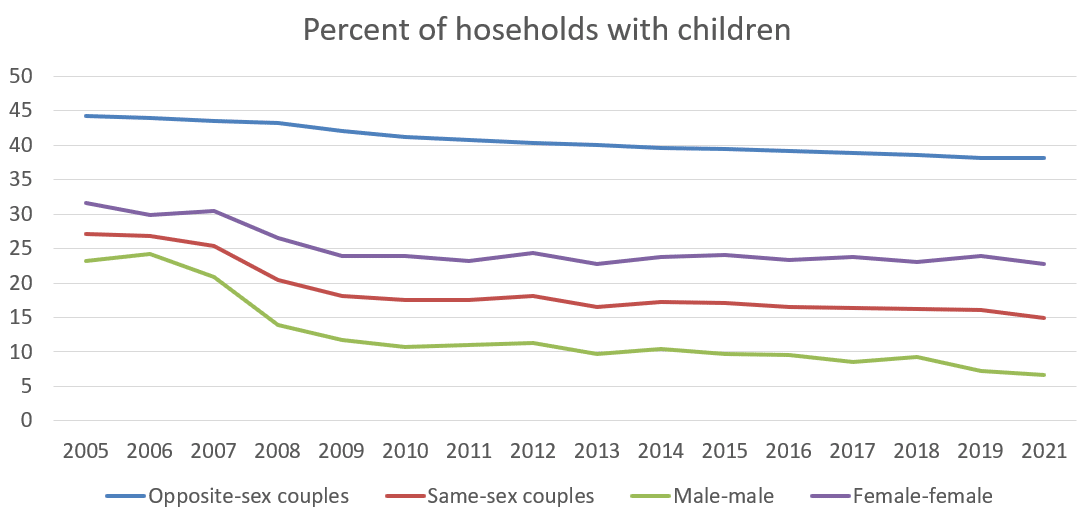![How Many Same-sex Couples Are Parents [Statistics]](https://wp.bedbible.com/wp-content/uploads/2024/06/Same-sex-parents-statistics.png)
In this article, we examine the prevalence of children in same-sex households and provide insights into the characteristics of these families.
This meta-study, includes data from the US Census Bureau and research from academic institutions, to present a comprehensive picture of same-sex parenting. From the number of children in the household to the age distribution of those children, we explore key findings on the presence of children in same-sex households.
Table of contents:
- Percent of Same-sex Couples Households With Children
- What Percent of Gay Men and Lesbian Women Are Biological Parents
- Same-sex Couples Have Smaller Families (less children)
- Number of Lesbian or Gay Parent Households
- Williams Institute Findings
- Family Equality Statistics on LGBTQ+ Parents
- Outcomes of Children Raised by Same-sex Parenting
Key Takeaways
- 16 percent of same-sex couples have children.
- Only 6.6 percent of male-male couples have children compared to 22.7 percent of female-female couples.
- Same-sex couples are half as likely as different-sex couples to have children.
- Lesbian couples are 3.4 times more likely to have children than gay couples.
- Heterosexual couples are 1.7 times more likely to have children than lesbian couples and 5.8 times more likely to have children than gay couples.
- Same-sex couples have smaller families than different-sex couples.
- Same-sex couples are more likely to adopt children or have stepchildren.
- Children raised by same-sex parents have similar scholastic outcomes to children raised by different-sex parents.
Percent of Same-sex Couples Households With Children
In the following, we used Census.gov data to illustrate the percentage of households with children.
The main findings show:
- The percentage of same-sex couples with children has dropped from 27 percent in 2005 to 15 percent today.
- In comparison, the percentage of different-sex couples with children has only dropped from 44 percent to 38 percent.
- Gay couples are the least likely demographic to be parents, only 6.6 percent of male-male households (1 in 15 gay couples).
- In comparison, 22.7 percent of lesbian couples have children in the household (1 in 4 lesbian couples).
- Lesbian couples are 3.4 times more likely to have children compared to gay couples.
- Heterosexual couples are 1.7 times more likely to have children compared to lesbian couples, and 5.8 times more likely to have children compared to gay couples.

| Year | Opposite-sex couples (%) | Same-sex couples (%) | Male-male (%) | Female-female (%) |
|---|---|---|---|---|
| 2005 | 44.2 | 27.2 | 23.2 | 31.7 |
| 2006 | 43.9 | 26.8 | 24.2 | 29.9 |
| 2007 | 43.6 | 25.4 | 20.8 | 30.5 |
| 2008 | 43.2 | 20.5 | 13.9 | 26.5 |
| 2009 | 42.0 | 18.1 | 11.8 | 23.9 |
| 2010 | 41.2 | 17.5 | 10.7 | 23.9 |
| 2011 | 40.7 | 17.5 | 11.0 | 23.2 |
| 2012 | 40.3 | 18.1 | 11.4 | 24.3 |
| 2013 | 39.99 | 16.47 | 9.74 | 22.82 |
| 2014 | 39.6 | 17.3 | 10.4 | 23.7 |
| 2015 | 39.4 | 17.2 | 9.7 | 24.1 |
| 2016 | 39.2 | 16.5 | 9.5 | 23.3 |
| 2017 | 38.9 | 16.4 | 8.5 | 23.8 |
| 2018 | 38.6 | 16.3 | 9.3 | 23.0 |
| 2019 | 38.1 | 16.1 | 7.2 | 24.0 |
| 2021 | 38.2 | 15.0 | 6.6 | 22.7 |
What Percent of Gay Men and Lesbian Women Are Biological Parents
What the above statistics do not show about the percentage of gay men and lesbian women who have children is whether both partners a parents of the child.
Looking into the statistics we find that of the 292,000 children living with same-sex parents 66.3 percent were the child of both partners.
In comparison, 95.7 percent of children living with opposite-sex (heterosexual) partners are the children of both.
If we look at the percentage of same-sex households with biological children we find that:
- 71.2 percent of lesbian couples with children are the biological parents of the children.
- 66.6 percent of gay couples with children are the biological parents of the children.
Adoption
Same-sex parents are four times more likely to have adopted children or stepchildren in their house, compared to different-sex parents.
- 3.1 percent of opposite-sex couples have adopted a child.
- In comparison, only 1.1 percent of different-sex couples have adopted a child.
When looking at those numbers between the group of same-sex couples with children we find that:
- 18.2 percent of lesbian couples with children have adopted a child.
- 31.4 percent of gay couples with children have adopted a child.
Another closely related activity is being a foster child.
- Same-sex couples are more likely than opposite-sex couples to foster children.
- 0.5 percent of all same-sex couples have a foster child.
- 0.2 percent of different-sex couples have a foster child.
Step-children in same-sex households
- 18.8 percent of children in lesbian households are step-children of their parents.
- 5.8 percent of children in a gay household are step-children of their parents.
Same-sex Couples Have Smaller Families (less children)
Looking at all the same-sex couples 54.7 percent only have one child in the household.
In comparison, 39.2 percent of opposite-sex couples only had one child in the household.
Number of Lesbian or Gay Parent Households
In the US there are 1,209,000 same-sex households, of which children are living in 172,887 (14.3 percent) of those households.
There are 577,600 gay households and 631,900 lesbian households.
- There are 38,122 gay households with children in the US (6.6 percent of all gay households).
- There are 143,441 lesbian households with children in the US (22.7 percent of all lesbian households).
- In summation, there are 3.8 times as many lesbian households with children, compared to gay households.
Williams Institute Findings
- 114,000 same-sex couples are raising children in the US
- 705,000 same-sex couples live in the US
- 50.5 percent of same-sex couples (357,000) are married.
- 24 percent of lesbian couples are raising children in the US.
- 8 percent of gay couples are raising children in the US.
- 21 percent of same-sex couples are raising an adopted child, in comparison, 3 percent of different-sex couples are raising an adopted child.
Family Equality Statistics on LGBTQ+ Parents
The number of children being raised by LGBTQ+ parents is significant, with between 2 million and 3.7 million children under age 18 estimated to have at least one LGBTQ+ parent. Of these children, many are being raised by a single LGBTQ+ parent, or by a different-sex couple where one parent is bisexual. In total, approximately 191,000 children are being raised by two same-sex parents.
The LGBTQ+ community plays a significant role in raising children in the US, with an estimated 29% of LGBTQ+ adults raising a child who is under 18. These statistics come from a variety of sources, including LGBT Demographic Data from 2019, a 2019 Press Release, and research from Gates on Marriage and Family in 2015.
It is important to note that while LGBTQ+ individuals and families have made significant strides in gaining legal recognition and protection, discrimination and stigma still exist. These issues can impact LGBTQ+ parents and their children, including access to healthcare, employment, and education. Society needs to continue to work towards creating a more accepting and inclusive environment for all families, regardless of sexual orientation or gender identity.
- Between 2 million and 3.7 million children under age 18 have at least one LGBTQ+ parent.
- Many of these children are raised by a single LGBTQ+ parent or by a different-sex couple where one parent is bisexual.
- About 191,000 children are being raised by two same-sex parents.
- An estimated 29% of LGBTQ+ adults are raising a child under 18.
- These statistics come from various sources, including LGBT Demographic Data (2019), a 2019 Press Release, and Gates’ research on Marriage and Family in 2015.
- Discrimination and stigma still exist for LGBTQ+ individuals and families, which can affect their access to healthcare, employment, and education.
- Society needs to work towards creating a more accepting and inclusive environment for all families, regardless of sexual orientation or gender identity.
Outcomes of Children Raised by Same-sex Parenting
The presence of children in households
- Approximately 1 in 6 (16 percent) same-sex couple households have children (biological, step, or adopted).
- Male-male households (10 percent) are half as likely as female-female households (22 percent) to have children present. In contrast, 41 percent of opposite-sex couple households have children present.
Number of children in households
- Around half of same-sex parents (52 percent male-male and 50 percent female-female) have only 1 child in the household.
- Twenty-nine percent of male-male parents report having 2 children in the household compared to 36 percent of female-female parents.
- Slightly more male-male parents (19 percent) report having 3 or more children in the household than female-female parents (14 percent).
- Only 39 percent of opposite-sex parents have 1 child in the household, 39 percent have 2, and the remaining 22 percent have 3 or more children in the household.
Age distribution of children
- Similar proportions of male-male parents (46 percent) and female-female parents (43 percent) report that their youngest child is less than 6 years old.
- The age distribution is similar for opposite-sex parents: 46 percent have a youngest child less than 6 years old, while the remaining 54 percent report their youngest child is 6 to 17 years old.
Race
- A smaller proportion of White same-sex couples report having children in the household compared to non-White same-sex parents.
- Only 7 percent of White male-male couples have children in the household, according to Figure 4. Similarly, fewer White opposite-sex couples (35 percent) have children in the household than their non-White counterparts (45-60 percent).
- The highest presence of children in same-sex couple households is among Black female-female couples (35 percent). Among opposite-sex couple households, the presence of children is highest among Hispanic couples (60 percent).
Education
- Female-female couples report similar proportions (20-25 percent) of having children in the household, regardless of their level of education.
- Male-male couple households show significant educational differences in the presence of children.
- 34 percent of male-male couple households where the head of the household has less than a high school education have children.
- Only 6 percent of male-male couple households where the head of the household has at least a Bachelor’s degree have children.
- Opposite-sex couple households show no educational gradient in the proportion of having children.
- However, a greater proportion of opposite-sex couples with a Bachelor’s degree (43 percent) have children in the household than same-sex couple counterparts (13 percent).
Sources: https://journals.sagepub.com/doi/full/10.1177/0003122420957249 and Gates, G., & Ost, J. (2004). The gay and lesbian atlas. Washington, DC: Urban Institute. Press. and Lofquist, D. (2012). Proceedings from PAA 2012: Same-sex couples’ consistency in reports of marital status. San Francisco, CA and https://www.familyequality.org/resources/facts-about-lgbtq-families/ and https://williamsinstitute.law.ucla.edu/publications/same-sex-parents-us/ and https://www.aamft.org//Consumer_Updates/Same-sex_Parents_and_Their_Children.aspx and
